Sexual Health & Wellbeing Survey: Main Findings
This report summarises findings from an online survey of 1,500 adults in Scotland who had been in a sexual relationship in the past year.
2 Main findings
Relationship background
Sexual orientation
2.1 Ninety-three per cent (N=1,409) stated that they are heterosexual, 3% lesbian or gay and 3% bisexual. Six per cent of respondents (n=91) identifying themselves as LGB is consistent with other online surveys. There are age and gender differences across respondents who described themselves
as LGB:
- 18-29 years old: 7% are bisexual and 5% gay or lesbian;
- 30-39 year olds: 3% are bisexual and 4% are gay or lesbian;
- 4% of men are gay and 3% bisexual;
- 2% of women are lesbian and 3% are bisexual.
Relationship status
2.2 Three percent of married people and 2% of those 'living as married' who responded to the survey are not currently sexually active.
2.3 Two percent of all respondents are currently in a sexual relationship with more than one person (Chart 3) and this rises to 16% of LGB participants, although caution is required due the small numbers of LGB respondents. Two percent of married people (3% of those 'living as married') are in a sexual relationship with more than one person, and 8% of those who are currently separated after marriage are in a sexual relationship with more than one person. Twenty-seven percent of divorced and 23% of those who are widowed are not currently in a sexual relationship.
Chart 3: Sexual relationship status
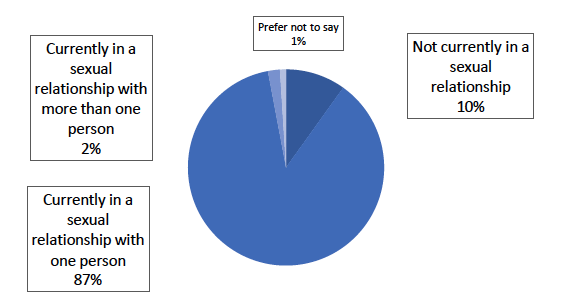
Question: A1. Which of these is true for you at the moment?
Base: all (1,516).
2.4 Three percent of men are in a relationship with more than one person, compared to 2% of women. There were no significant differences across age groups, social grades or ethnicity in terms of having multiple partners.
Happiness and wellbeing
2.5 Seventy-one percent feel happy with their sexual relationship(s) and 63% with their sex life specifically (Chart 4). This is comparable with NATSAL-3 which reported that 60% were satisfied with their sex life.[2]
2.6 More women are likely to say they 'feel happy with my sexual relationship(s)'. This higher level of agreement among women is expressed through 75% agreeing, compared to 67% of men. Younger age groups are also more likely to be happy. For example, this is the case for 74% of 18-29 year olds and 76% of 30-39s; in comparison 67% of 50-59s agree.
2.7 Most respondents are happy with both their sexual relationship(s) and with their sex life. However, heterosexual people are significantly happier with their sexual relationships than LGB people - 71% against 63% and the same is true when they consider their 'sex life'. Sixty-three percent of heterosexual people agree they are happy with their sex life, compared to 56% of LGB people.
2.8 Those with a disability or limiting illness are less likely to be happy with their sexual relationships and sex life (a finding which will also relate to age for some respondents). For example, 48% are happy with their sex life, compared to 67% of those without a disability or illness.
Chart 4: Thinking about the past year, how much do you agree or disagree with the following statements?
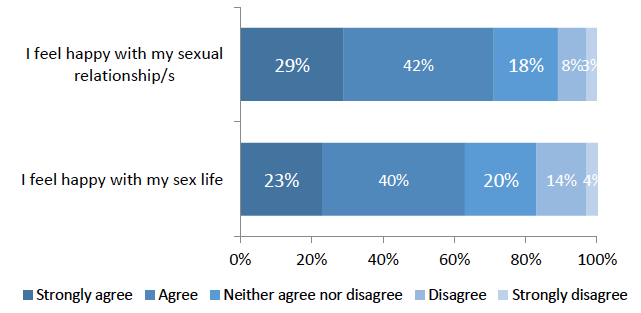
Question: Thinking about the past year, how much do you agree or disagree with the following statements?
Base: all (1,516)
2.9 There were no significant differences between people on the basis of social grade or marital status.
2.10 The majority of people had positive emotional experiences the last time that they had sex (Chart 5). Those with a disability were less likely to feel safe and comfortable though: 88% agreed compared with 92% without a disability or illness.
Chart 5: The last time you had sex… how much do you agree or disagree that you …?
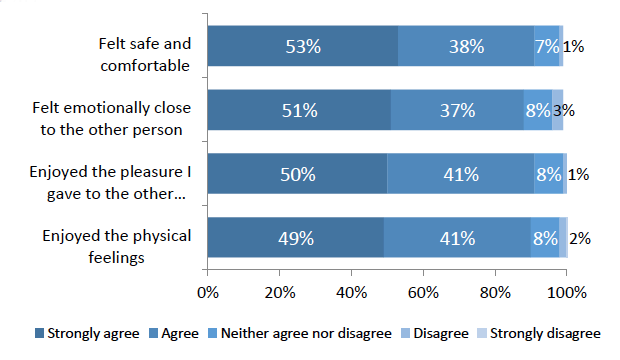
Question: The last time you had sex … how much do you agree or disagree that you?
Base: all (1,516)
2.11 Men are more likely to agree that they enjoyed the physical feelings (92%) than women (88%) but again enjoyment is lower among those with a disability (86%) than without (91%).
2.12 Those who have never been married are less likely to have felt safe and comfortable and emotionally close to the other person. Seventy-nine percent of those 'never married' felt emotionally close to their sexual partner the last time they had sex, compared to 91% of married people and 90% of those 'living as married.' Eighty-five percent felt safe and comfortable the last time, again compared to 93% of married and 91% of those 'living as married.'
Health condition
2.13 Respondents were asked about their general health: 'Are your day-to-day activities limited because of a health problem or disability which has lasted, or is expected to last, at least 12 months?' Thirty percent reported that they have a long term disability or health condition which impacts on their daily activities either 'a lot' or 'a little'.[3]
2.14 They were specifically asked whether, 'In the past year, have you had any health conditions or disability that you feel has affected your sexual enjoyment in any way?' Nearly a quarter (23%) have had a health condition that has affected their sexual activity and enjoyment in the last year. The prevalence of this rises significantly with age but still affects 13% of those aged 18-29. It is more likely to be the case among men (Chart 6).
2.15 Although those with a disability or limiting illness are much more likely to feel that they have a condition that affects sexual activity, 39% feel that their disability does not affect them. Married and widowed people are more likely to have conditions that affect their sex life than those who have not been married and this reflects the age profile of those groups.
2.16 Health conditions were noted more by those living in rural locations. Thirty-two percent of those living in rural Scotland feel that they have a condition affecting their sex life, compared to 22% of people in urban places and 23% in 'town and fringe' locations. There are no differences between people across the social grades.
Chart 6: Effect of health condition or disability on sexual activity and enjoyment
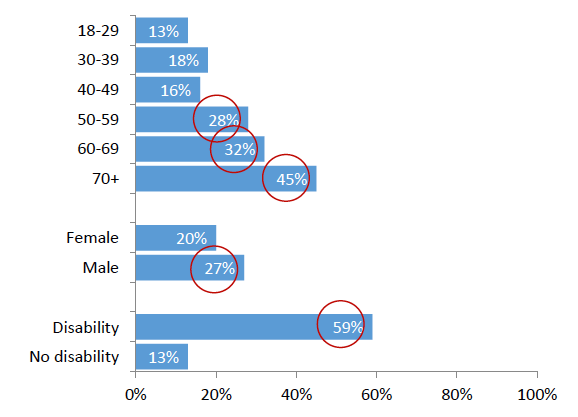
Question: A4. In the last year, have you had any health conditions or disability that you feel has affected your sexual enjoyment in any way?
Base: all (1,516)
Scale: yes; no; prefer not to say.
How often they have sex
2.17 Forty-five percent of the survey participants have sex at least once a week or more often and another 34% at least once a month (Chart 7). Frequency of sexual activity falls with age, peaking with 60% of 18-29s having sex at least once a week or more often.
Chart 7: How frequently they have sex
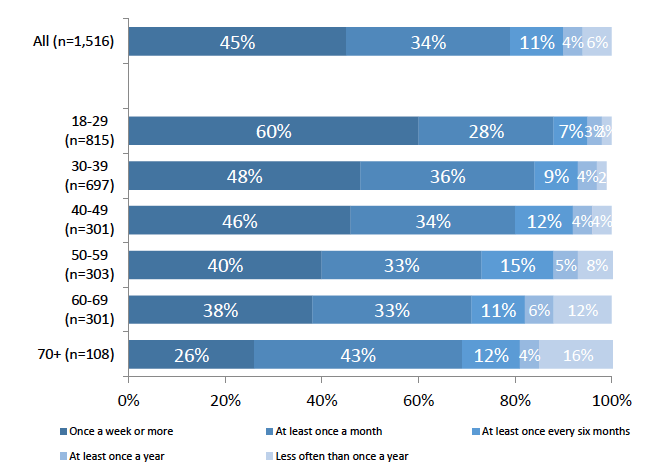
Question: A5. One average which of the following best applies to you? I have sex…
Base: all (1,516)
2.18 Those with a disability or illness have sex less frequently: 36% have sex once a week or more often, compared to 47% without a disability.
2.19 There are no differences by social grade, but those who are divorced (63%), separated (55%), never married (57%) and living as married (47%) are more likely to be having sex once a week or more often, compared to married people (38%).
Talking about sex
2.20 Respondents were asked how easy or difficult they would find it to discuss a range of issues with a partner (Chart 8).
2.21 Conversations about Sexually Transmitted Infections (STIs) are felt to be the most difficult type of discussion with a partner. Twenty-three percent of those who feel that this issue is applicable to them said that they would find talking about it 'difficult' or 'very difficult.' LGB respondents (n=91) would tend to find it more difficult than heterosexuals: 25% describe it as 'difficult' and 2% 'very difficult'. This contrasts with 17% for heterosexual people.
2.22 Women find it easier to discuss STIs. Sixty per cent describe it as 'easy' or 'very easy' to have those conversations compared to just 48% of men.
2.23 Older people are less likely to feel that the issues asked about are applicable to them, in fact 48% of 60-69s believe that it is the case and that rises to 59% of over 70s.
Chart 8: When talking about sex with your current or most recent partner, how easy or difficult would it be for you to …….?
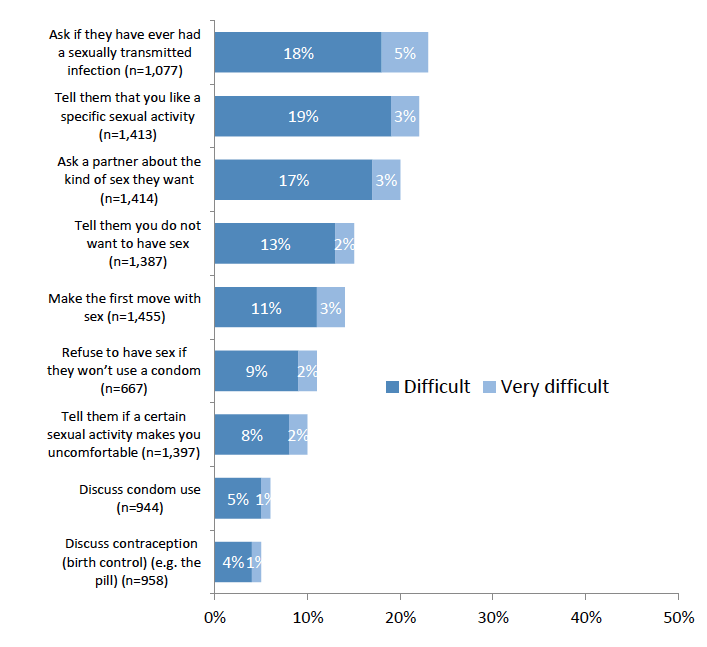
Question: B1. When talking about sex with your current or most recent partner, how easy or difficult would it be for you to …….?
Base: excludes not applicable, as shown
Scale: very difficult; difficult; easy; very easy; not applicable to me.
2.24 Excluding those who feel it is not applicable to their circumstances, 8% of 18-29 year olds would find it difficult to refuse to have sex if a sexual partner would not use a condom, a proportion that falls to 5% of those aged 40-49. Twenty-one percent of LGB respondents would find it difficult to refuse to have sex if a sexual partner will not use a condom, compared to 11% of heterosexuals. However, with a small sample size of 91 it is not possible to draw firm generalisations to the wider LGB population.
2.25 Twenty percent of those with a disability find it difficult to tell a partner they do not want to have sex. This compares to 13% of those without a disability. There are no significant differences between those of different social grades.
2.26 Ten percent of those surveyed from a minority ethnic background find it difficult to discuss contraception, compared to 5% of white people. Similarly 10% of minority ethnic people find it difficult to discuss condom use, compared to 6% of those from a white background, and 16% would find it difficult to refuse sex if their partner will not use a condom compared to 11% of white people. However, the minority ethnic sub-sample is small (n=154 unweighted) so drawing generalisations for the wider minority ethnic population cannot be done on the basis of these data.
2.27 Those who are 'living as married' are more likely to find most of the issues easy to talk about than those who are married. This is the case for asking a partner about the kind of sex they want - 41% of those 'living as married' find this very easy compared to 32% of married people. For many of the married people surveyed issues such as condom use and contraception were felt not to be relevant for their circumstances.
2.28 Those who have never been married are more likely to find these issues difficult. For example, 16% find it difficult to say if a certain sexual activity makes them uncomfortable. This is only the case for 5% of those 'living as married' and 8% of married people.
Experience of sexual health and other issues affecting one's sex life
2.29 Participants were asked about their experience, in the past year, of a number of sexual health issues which had lasted for at least three months (Chart 9).
2.30 Fifty-eight percent of people had experienced at least one sexual health or wellbeing issue in the last year. The proportion with at least one issue was the same for both men and women.[4]
2.31 Having and keeping an erection was a problem for 14% of men, although significantly more so for older groups. It affected just 3% of 30-39s, but a quarter of 60-69s and 31% of over 70s.
2.32 Younger people were especially prone to feelings of anxiety: this was the case for 22% of 18-29s, a figure that fell to just 9% of those in their 30s.
2.33 The higher frequency of sexual activity among those 'living as married' will explain why they have experienced more sexual issues in the last year: 62% have done so, compared to 56% of married people and 57% of those 'never married.' Getting/keeping an erection is the only issue that married people have experienced more than those 'living as married', which will partly be related to their different age profile.
Chart 9: In the last year, have you experienced any of the following for a period of three months or longer?
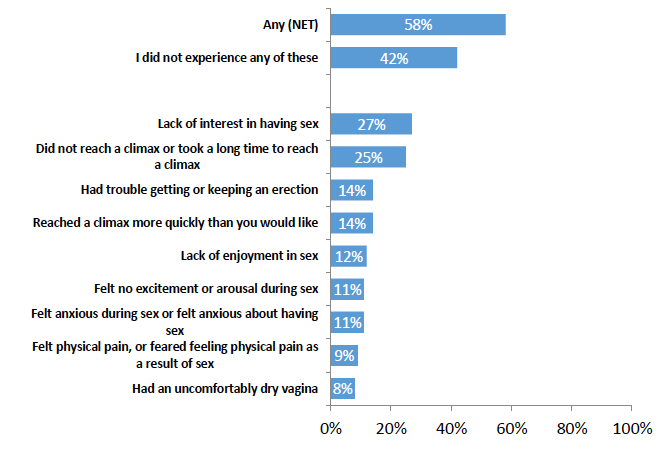
Question: C1. In the last year, have you experienced any of the following for a period of three months or longer?
Base: all (1,516)
2.34 People on average experienced 1.7 of these issues, a higher number among men (1.8) than women (1.6). Those with a disability or illness had two issues on average, but there were no differences between people of different ethnicities or on the basis of social grade.
2.35 Young people have the highest number of issues (2.1) and those in their thirties the lowest (1.6). Sixty-five percent of 18-29s had experienced at least one issue (Chart 10). The number of issues chosen by LGB people was higher than heterosexuals. This was particularly the case for anxiousness (23%, compared to 11% for heterosexual people).
Chart 10: At least one issue by key demographics
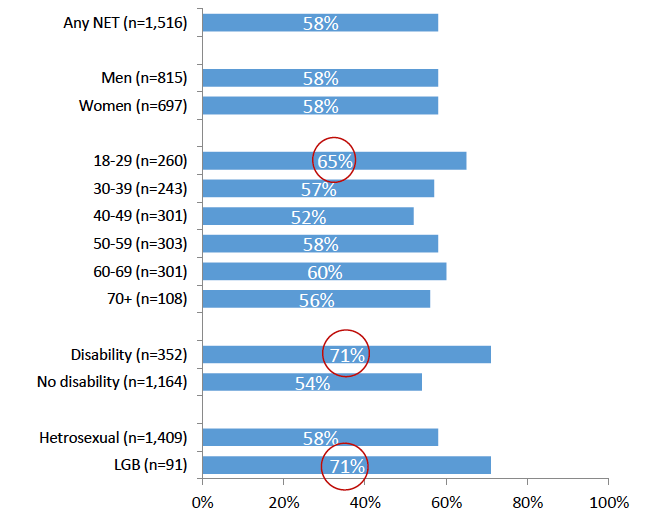
Question: C1. In the last year, have you experienced any of the following for a period of three months or longer?
Base: 1,516
2.36 Participants were also asked the degree to which experience of a specific issue had caused them distress. Difficulties with getting or keeping an erection caused the most concern for those who had experienced this: 21% of men were 'very distressed' and 28% 'fairly distressed' (Chart 11). For 13% of women who had experienced an uncomfortably dry vagina it was 'very distressing.'
2.37 The most common issues, such as a lack of interest and not reaching a climax, were felt to be less distressing. Men were however more distressed than women with the latter: 27% found it 'very' or 'fairly' distressing, compared to 16% of women.
Chart 11: All who felt a little/fairly/very distressed by sexual issues they had experienced in the last year - in order of 'very distressed'
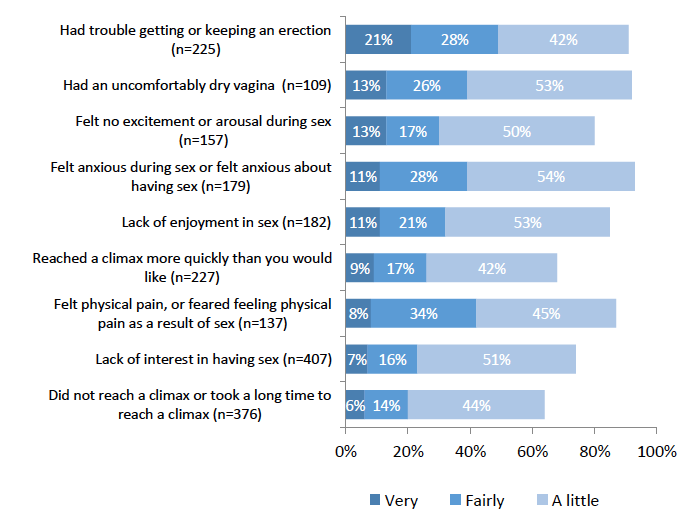
Question: C2. And how did you feel about this?
Base: those who had experienced the issues in the last year (as shown)
Scale: very distressed; fairly distressed; a little distressed; not at all distressed.
2.38 The survey asked people if they had avoided sex in the past year in connection with several sexual difficulties, either their own or their (ex)partner's. Overall, 21% have avoided sex in the last year because of sexual difficulties: 22% of men and 19% of women (Chart 12).[5]
2.39 Those in the older age groups were more likely to have avoided sex, as were those with a disability or illness (38%). LGB people were no more or less likely to have avoided sex because of difficulties than heterosexual people.
2.40 There were no significant differences between people on the basis of social grade or marital status.
Chart 12: Avoiding sex because of sexual difficulties (own or (ex)partner's)
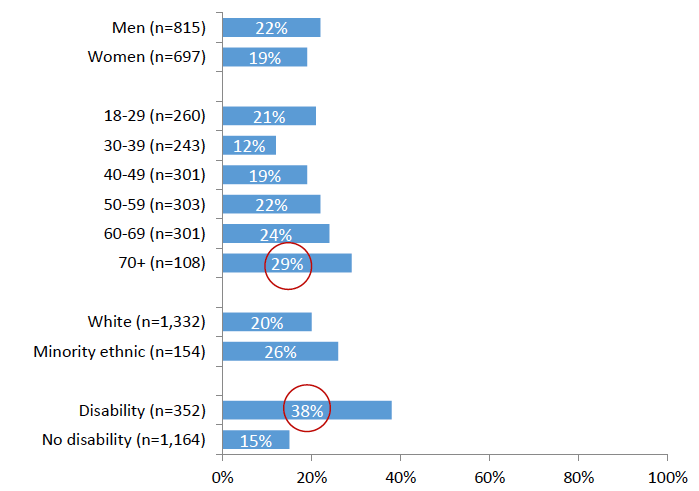
Question C3: Have you avoided sex in the last year because of sexual difficulties, either your own or your partner's?
Base: All (as shown).
Scale: yes; no; prefer not to say
2.41 Over half (55%) of men who had avoided sex did so because of erectile problems (Chart 13). Fifty-seven percent of women avoided sex because of a lack of interest, compared to just 32% of men. Thirty-six percent of women who had avoided sex did so because of physical pain or the fear of pain, which compares to just 16% of men.
2.42 Among those who had avoided sex, the average number of reasons was highest for the 18-29s (2.6) and those in their fifties (also 2.6). Young people were especially likely to highlight anxiousness and pain or the fear of pain. For older people the main issue was getting or keeping an erection. This was a reason for 44% of 60-69 year olds who had avoided sex and 61% of those over 70, again based on those who had avoided sex in the last year rather than everyone.
2.43 Twenty-one percent of those from social group C2DE had avoided sex due to previous difficulties in reaching a climax, compared to 9% of ABC1s, and 23% of C2DEs expressed a lack of sexual enjoyment as a reason for avoidance compared to just 13% of ABC1s.
Chart 13: Reasons for avoiding sex
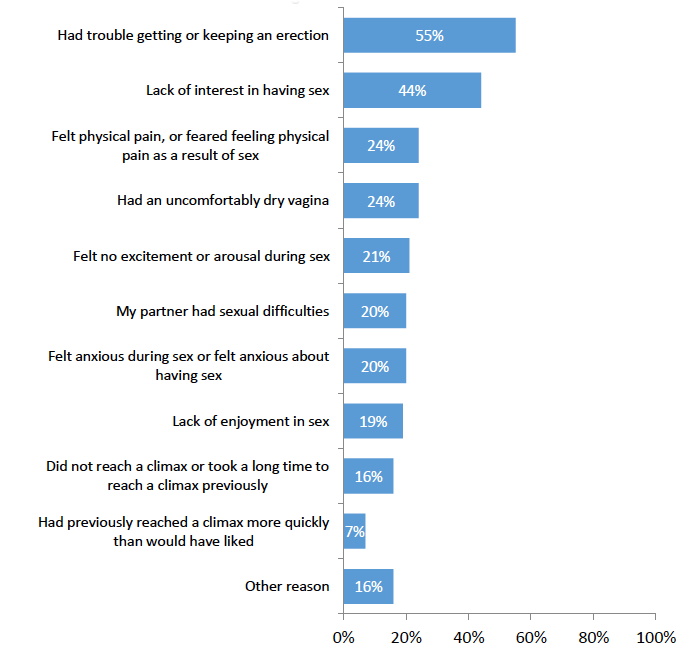
Question: C4. For which, if any, of the following reasons did you avoid sex in the last year?
Base: All who avoided sex in the last year (311)
Seeking advice and support
2.44 A question was included to gather information about advice-seeking behaviours in the past year with a number of advice source options provided for respondents. Twenty-two percent of people have sought advice about their sex life in the last year. The figure is significantly higher among young people aged 18-29 (43%) (Chart 14). The same is true for LGB respondents (n=91), with 39% seeking advice compared to 21% of heterosexuals surveyed, and 31% of those from a minority ethnic background (n=154) compared to 21% of white people, although the numbers are small for both LBG and minority ethnic respondent groups.
2.45 Those who have 'never married' were the most likely to have sought advice (37%), compared to 16% of married people and 20% of those 'living as married.' There was no difference on the basis of social grade.
Chart 14: Seeking help or advice about your sex life
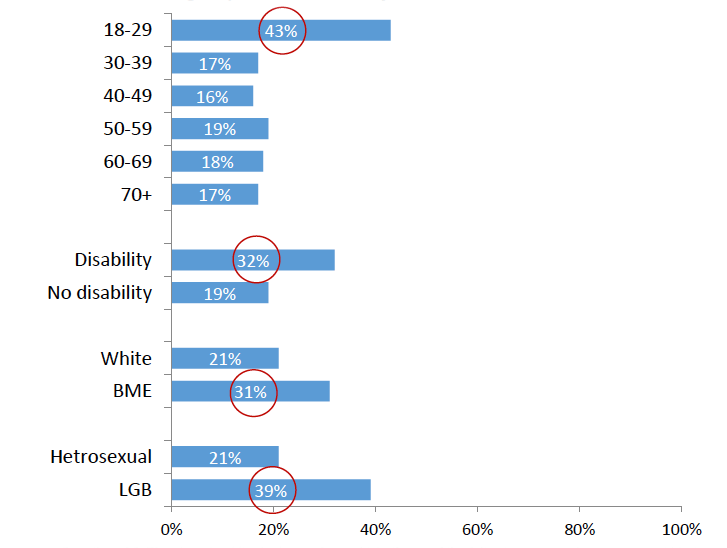
Question: C5. Thinking about the last year, from which, if any, of the following sources have you sought help or advice regarding your sex life?
Base: all (1,516)
2.46 Twelve percent of men and 7% of women had consulted their GP about a sex related issue in the last year (Chart 15). The proportion using websites and family or friends was driven by young people especially, 21% of 18-29 year olds had talked to family or friends and 25% had used websites for information. Once family or friends are excluded as a source, the proportion of 18-29 year olds who had gathered some help or advice from elsewhere fell to 36% from 43%.
2.47 Eight percent of 18-29s had used a sexual health clinic. Older people tended to gain advice from their GPs (14% of over 70s).
2.48 Those 'never married' are especially likely to have spoken with friends and family (17%) and to have checked 'other websites' (17%). Others 'living as married' are more likely to have done both of these than married people.
2.49 Ten percent of LGB respondents had used sexual health clinics in the last year, compared to just 2% of heterosexuals. Seventeen percent of LGB people had found information from websites and 10% from family or friends.
2.50 C2DEs are more likely to have visited their GP/family doctor (11%) compared to 8% of ABC1s.
Chart 15: Where they go for advice or information
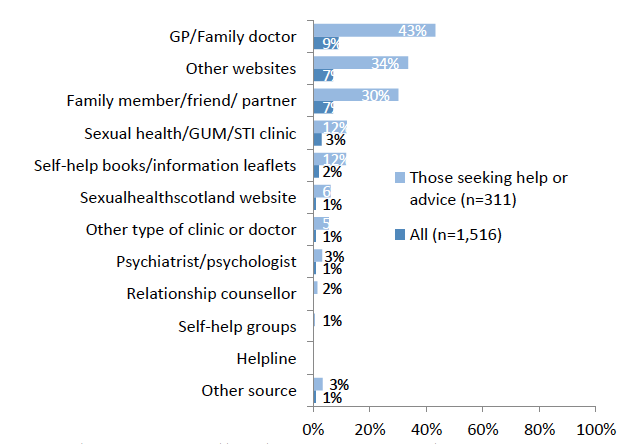
Question: C5. Thinking about the last year, from which, if any, of the following sources have you sought help or advice regarding your sex life?
Base: as indicated
Regret
2.51 Participants were asked how many times in the last year they had had sex which they regretted. Ten percent reported that they had at least once had sex they regretted (Chart 16). The figure was driven by people aged 18-29 (21%) and LGB respondents (19%), although, as cautioned elsewhere, the LGB respondent numbers were small due to the representative nature of
the sample.
2.52 Four percent of people had sex they regretted once in the last 12 months, for 3% it was twice and for a further 3% it was three or more times. Of 18-29 year olds, 9% had done so once, 5% twice and 7% three or more times.
2.53 Of those from a minority ethnic background, 16% had sex they regretted. Again, caution is needed with the small base number (n=154).
2.54 C2DEs were more likely than ABC1s to have had sex they regretted (11% versus 8%).
2.55 Incidences of regret were significantly more prevalent among those 'never married' (21%) with 10% having done so once, 5% twice and 6% three times or more. In comparison, only 6% of married people had sex they regretted and 10% of those 'living as married.'
Chart 16: Having had sex that they regretted - at least once in the last 12 months
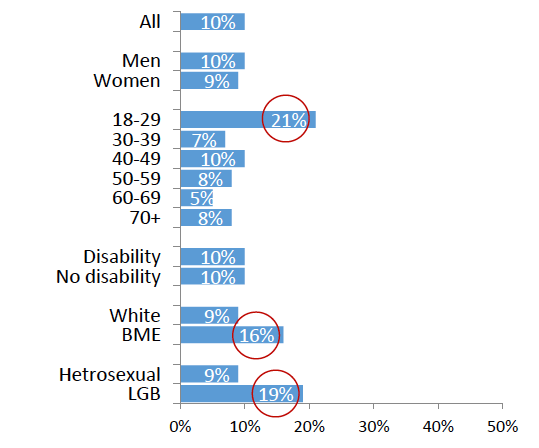
Question: E1. In the last year how many times have you had sex you regretted?
Base: all those excluding 'prefer not to say' (1,370)
2.56 Seven percent said that in the last year being drunk had got in the way of having enjoyable sex (Chart 17): 2% of all people said this had happened once in the last year, 2% said twice, and for 3% it had occurred three times or more.
Chart 17: Being drunk affecting sex
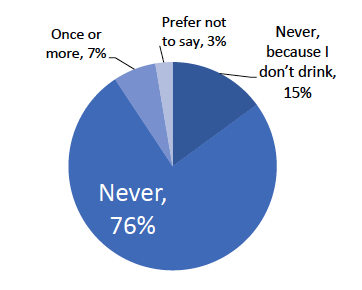
Question: f1a. In the last year, how many times have being drunk got in the way of your being able to have enjoyable sex?
Base: all (1,516)
2.57 Again the numbers were driven by younger people. Being drunk had affected 18% of 18-29s: 5% just once, 5% twice and 7% three times or more (Chart 18).
2.58 Twenty-two percent of those from a minority ethnic background stated that it had not occurred because they did not drink, which compares to 15% of white respondents.
2.59 Those currently married and 'living as married' were the same (for 6% alcohol had got in the way of enjoyable sex), but significantly more of those 'never married' had experienced this in the last year (16%). There were no significant differences between LGB and heterosexual people, on the basis of social grade, or between men and women in general.
Chart 18: Being drunk affecting sex, by demographic differences - at least once in the last 12 months
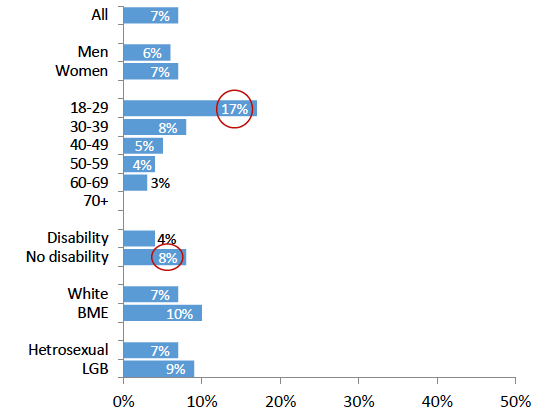
Question: f1a. In the last year, how many times have being drunk got in the way of your being able to have enjoyable sex?
Base: All excluding those answering prefer not to say (1,477)
2.60 In response to the question, "In the last year, how many times has being high (taking drugs) got in the way of your being able to have enjoyable sex?", just 1% of people stated that drug use had affected their sexual activity.
2.61 Nearly all of those who stated that drugs had affected their sexual activity were aged 18-29.
Abuse
2.62 Respondents were asked if they had experienced, in the past year, a range of abusive behaviours by a partner or ex-partner. Each type of abusive behaviour asked about had been experienced by between 1% and 4% of people in the last year (Chart 19). Eight percent had experienced at least one of the five types. This was the case for 17% of those aged 18-24 (19% of women and 12% of men of that age). Sixteen percent of LGB people in the sample reported at least one of the five types, compared to 7% of heterosexuals.
2.63 Thirteen percent of those with a condition that limits them 'a lot' reported at least one type of abuse, which is significantly different to 7% without any disability. Among those with a very limiting condition there was evidence of abusive behaviour with 5% feeling forced to have sex in the last year, compared to 1% of the non-disabled population. Seven percent of those with a very limiting condition report being told by a partner whom they can see and where they can go which contrasts with 3% of those without a disability.
Chart 19: Abusive experiences in the last year
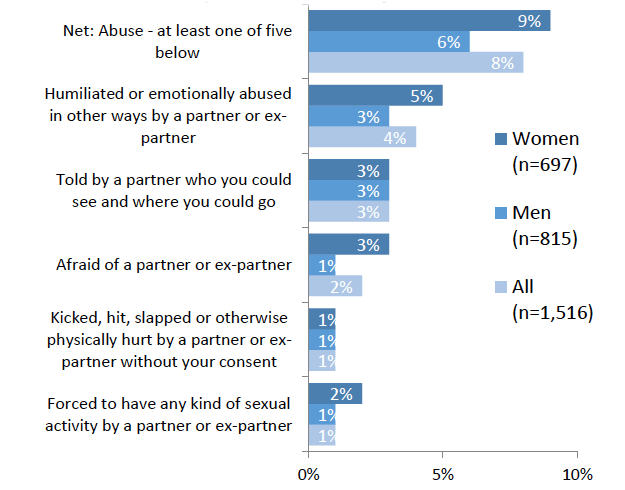
Question: And in the last year, have you been…?
Base: As indicated
2.64 Many of those affected by abusive experiences across the incidents are aged 18-24: 9% reported humiliation or emotional abuse and 6% had been told who they can see and where they can go (Chart 20).
2.65 There were no significant differences on the basis of ethnicity or social grade.
2.66 Two percent of women across the age groups had been forced into a sexual activity by a partner or ex-partner and 3% are afraid of their partner or ex-partner.
2.67 There were no significant differences between social grades. Those 'living as married' (6%) and 'never married' (8%) are most likely to report instances of humiliation or emotional abuse. In contrast just 3% of married people reported this type of abuse.
Chart 20: Abusive experiences in the last year (by age and gender)
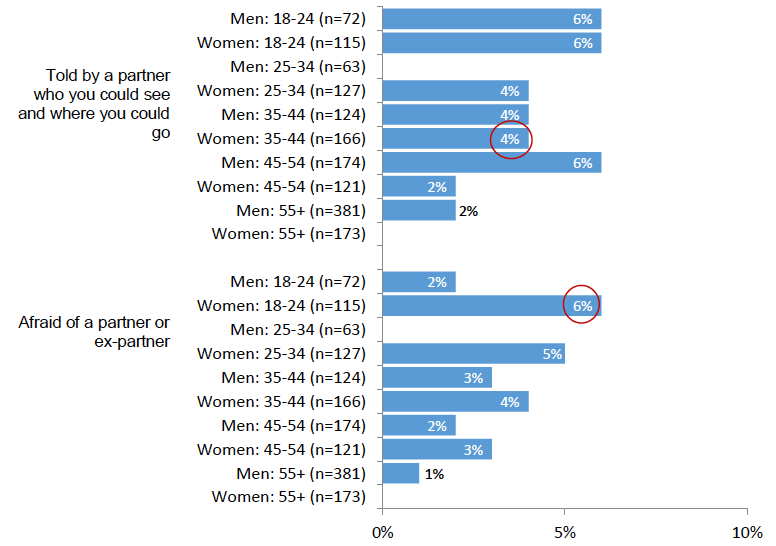
Question: F2a. And in the last year, have you been …?
Base: as indicated
Chart 21: Humiliation or emotional abuse in the last year (by age and gender)
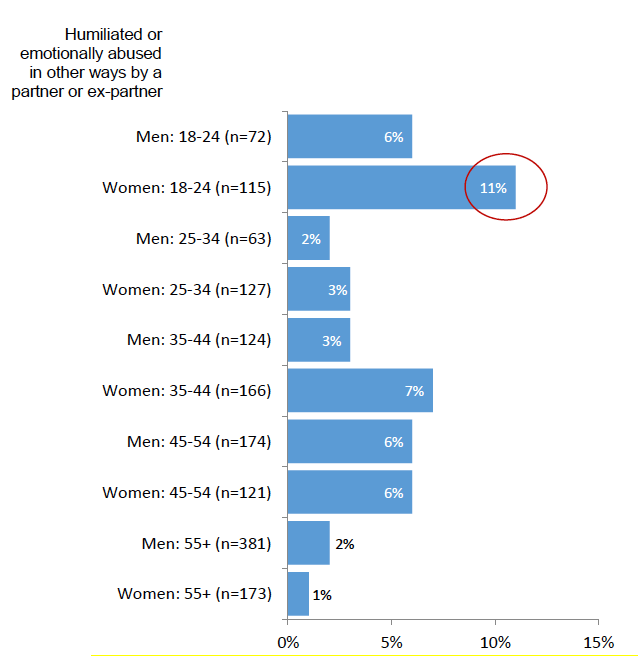
Question: F2a. And in the last year, have you been …?
Base: as indicated
2.68 Caution is needed given the small numbers involved, however six percent of minority ethnic respondents are afraid of a partner or ex-partner, compared to 2% of white people (Chart 22). Four percent had been 'kicked, hit, slapped or otherwise physically hurt' in the last year, compared to 1% of white people. Five percent of those 'never married' reported being afraid, compared to 1% of 'married' and two percent of those 'living as married.'
2.69 Abusive experiences appeared to be more prevalent for LGB respondents although the sample is small: for example, 10% reported being afraid of a partner or ex-partner compared to 2% of heterosexuals.
Chart 22: Abusive experiences in the last year (by significant variation in sexual orientation and ethnicity)
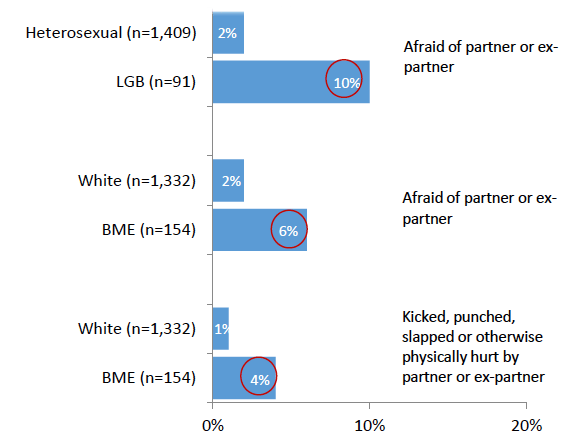
Question: F2.a. And in the last year, have you been …?
Base: As indicated
Contact
Email: Fiona MacDonald
There is a problem
Thanks for your feedback